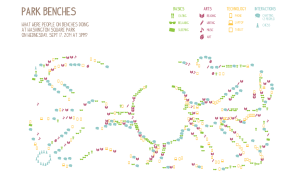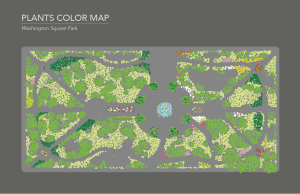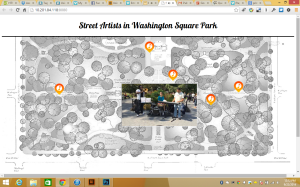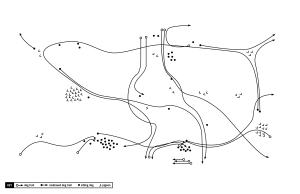Here’s the link for our presentation.
Author Archives: Sunnie Sang
Team Amy – Mapping Washington Square Park – (Amy, Sunnie, Melody)
Filed under Third Place Maps, Uncategorized
Sunnie – Quick Indie Project
As “sick customers” and “holding doors” cause the most train delay, I want to solve the problem from understanding the reason behind people’s behavior and design a public interface to pre-inform people before they hop on the subway. The aspects I took are from the previous project “Urban Fiction” – using data to understand behavior and solve problems, and the data is reference from the MTA Workshop. Also, interaction/information design to improve service efficiency and behavioral change is a potential direction of my thesis project.
My Quick Indie Project link is here.
Filed under Quick Indie Project
On “Third Places” – Sunnie
While reading the “Third Places” by Ray Oldenburg, two “Third Places” (scenes) came into my mind.
“Third Place” 1
The company where I did my internship this summer is located at W4st and Broadway. During the internship, I walked pass the Washington Square Park almost every morning and afternoon. In such an interesting and vibrant “third place”, this is what I saw: every morning around 9, echo from the folk guitar singer under the Washington Arch welcomed my entering the park; a group of NYU students gathered at the same place as always for their field trips; in the open area surround by summer herbs, the yoga group lying in grid breathing the morning air; homeless people find their shelter under the trees, running squirrels and wandering pigeons knew not to wake them up from the dreams on the grass bed… After 6pm, the park became an even more amazing“third place”, novel reading hipsters, Disco dancing guys, the comedy performance group, jazz band, excited tourists, chilling office ladies, laughing kids with Uncle Bubble, doodle artists… The park is a miniature of NYC that you can find all kind of amazement out of this informal gathering community. It makes me smile. Within a city with dense popularity and mostly vertical structure living/working style, the park creates a horizontal, wide “sorting areas” for people have shared interests; a safe and tolerant place for people to express themselves; also provide a sense of belonging, “the social anchors of community life”, which is essential for such a melting-pot city.
“Nor is it a coincidence that the joie de vivre cultures of the world are those in which third places are regarded as just as essential as home and work”, as Ray states in the article, ‘Joy in living’ depends upon people’s capacity to enjoy the company of those who live and work around them.” The chemistry generated by the community interaction and conversation bring life to the city, becoming one of the uniqueness of NYC’s characteristic. I think being exposure in this diverse community also help preventing falling in the restriction of “home-to-work-and-back-again” shuttle, create a psychological openness of mind.
“Third Place” 2
About four years ago, my grand parents who are in their 80s, moved into a new multi-floor apartment building. My families all felt happy about this move because the building located in the new CBD of the city they live in; the apartment was much newer and bigger than their old apartment; a within-10-minutes walk to the river side and the super market. However, my grandpa felt depressed after he moved in. He kept visiting back to the old place that located in the old town near a train station. It used to be a community that all his old retired coworkers live in. Around the area were many small stores and restaurants along the street. In my memory the it was always crowded and chaotic.
I still remember our talk on their new balcony. “I went to my old home yesterday”, grandpa said. “Why going back again? It’s so far to take a bus from here and you must feel tired after such a long commute”, I asked. He said, “it’s still so good. I could just have a simple lunch in the corner restaurant. I could picked up a newspaper and read there, like I used to do everyday.” “But now you can stroll along the river and go to the super market, and the environment in this area is much better”. After a long while, he sighed, “People are gone. My old friends all move into new apartments around the city, we couldn’t play Majiong like the old days. I used to know all the people from those stores and restaurants, sometimes I chatted with them and their kids. Now I have no one to talk to. I don’t like supermarket… Sometimes I just felt lonely.”
I felt sad about how the new isolated urban living style rudely change the way the elderly, like my retired grandpa, used to live. As young people who has work and more social life outside of where we live, the apartment building is more of a space where we close the door and sleep. We spend our spare time elsewhere, but not for my grandpa. He can’t stay in front of the computer and TV all day like us. His routine is highly connected to the walk-distance community – the courtyard, newsstand, farmers market, tailored store, restaurant, with all the familiar connection – he need those people to build up his retired life, to spend time, to communicate information, to have neighbor’s help when emergency happened, and to have a spiritual support from the accompany that their busy younger families couldn’t provide. Perhaps it requires city designers in China of more empathy to design the “third places” for the elderly’s accommodation.
Filed under Readings, Third Places




